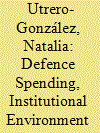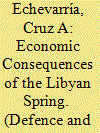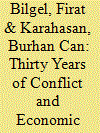| Srl | Item |
| 1 |
ID:
167860


|
|
|
|
|
| Summary/Abstract |
This paper analyses the impact of participating in a military alliance on the nexus between defence spending and economic growth. In particular, we study how the process of gradual association to a military organization influences the defence spending of newcomers, and consequently their economic growth. Conclusions from the theoretical model are tested empirically for countries in the North Atlantic Treaty Organization. Results show that the prospect of intensified military alliance partnership and membership has a positive effect on economic growth. In addition, increased security and stability gained by closer military cooperation reinforces the positive link with economic growth. Empirical evidence supports theoretical priors.
|
|
|
|
|
|
|
|
|
|
|
|
|
|
|
|
| 2 |
ID:
167863


|
|
|
|
|
| Summary/Abstract |
In 2011 a wave of revolutionary movements, the so-called Arab Spring, spread in the Middle East and North Africa. Libya was one of the most affected countries, ending Gaddafi’s dictatorship after an international intervention and a civil war. This paper assesses the effects that this revolution had on Libyan economy. The analysis is made by means of the synthetic control method. Our estimates for the 2011–2014 period show (i) a cumulative loss in the growth rate of per capita real GDP of 64.15%; (ii) a cumulative loss in per capita real GDP of 56,548 dollars; and (iii) a cumulative loss in the aggregate real GDP of 350.5 billion dollars.
|
|
|
|
|
|
|
|
|
|
|
|
|
|
|
|
| 3 |
ID:
167861


|
|
|
|
|
| Summary/Abstract |
In spite of government counter-terrorism expenditure and efforts, the incidence of terrorism in Nigeria appears to be rising. This paper examines the growth and fiscal consequences of terrorism in Nigeria by estimating the terrorism–macroeconomy relation using different measures of terror incidence. The results show that terrorism has an economically and statistically significant negative impact on growth; although this impact is considerably small and short-lived, manifesting only after a lag of about three years. Specifically, the cost of terrorism to Nigeria, in terms of lost GDP per annum, is estimated at 0.82%. Moreover, there is evidence that terrorism leads to the reallocation of economic activity away from private investment spending to government spending; that is, terrorism crowds out investment at a higher rate than its potential to crowd in government spending. Lastly, terrorism alters the composition of government expenditure – with the defence component of government expenditure rising vis-a-vis other expenditure items. The results are robust to allowing for dynamic interactions between terrorism and macroeconomic aggregates.
|
|
|
|
|
|
|
|
|
|
|
|
|
|
|
|
| 4 |
ID:
167859


|
|
|
|
|
| Summary/Abstract |
While not always a concern for the general economic growth literature, the debate over the effects of military spending on growth continues to develop, with no consensus, but a deepening understanding of the limitations of previous work. One important issue that has not been adequately dealt with is the endogeneity of military spending in the growth equation, mainly because of the difficulty of finding any variables that would make adequate instruments. This paper considers this issue, using an endogenous growth model estimated on a large sample of 109 non-high-income countries for the period 1998–2012. The empirical analysis is framed within an instrumental variable setting that exploits the increase in military spending that occurs when unrest in a country escalates to turmoil. The estimation results show that endogeneity arising from reverse causality is a crucial issue, with the instrumental variable estimates providing a larger significant negative effect of military spending on growth than OLS would. This result is found to be robust to different sources of heterogeneity and different time periods.
|
|
|
|
|
|
|
|
|
|
|
|
|
|
|
|
| 5 |
ID:
167864


|
|
|
|
|
| Summary/Abstract |
This study seeks to estimate the causal effects of PKK separatist terrorism on economic development in Turkey using the synthetic control method. By creating a synthetic control group that reproduces the Turkish Gross Domestic Product (GDP) before PKK terrorism emerged in the late 1980s, we compare the GDP of the synthetic Turkey and the actual for the period 1955–2008. Our study finds that the Turkish per capita GDP would have been higher by about $2600 had it not been exposed to terrorism. This translates into an average of 21.4% higher per capita GDP over a period of 21 years.
|
|
|
|
|
|
|
|
|
|
|
|
|
|
|
|
| 6 |
ID:
167862


|
|
|
|
|
| Summary/Abstract |
This paper examines the impact of civil war on military expenditure. We employ two measures of military expenditure: the share of military expenditure in general government expenditure and the logarithm of military expenditures. We would reasonably expect a priori that military expenditure as a share of general government expenditure increases during a civil war and that such increases would taper off over the duration of a civil war. We also explore whether the termination of a civil war induces a decline in the share of military expenditure as a share of the general government expenditure in the short-run. We find evidence the of share of military expenditure increases during a civil war and falls in the year succeeding the end of a civil war, and, in particular, if a war ends in a peace treaty. The level of military expenditures, however, rises during civil wars and does not appear to decline in the short-term after the end of a civil war.
|
|
|
|
|
|
|
|
|
|
|
|
|
|
|
|